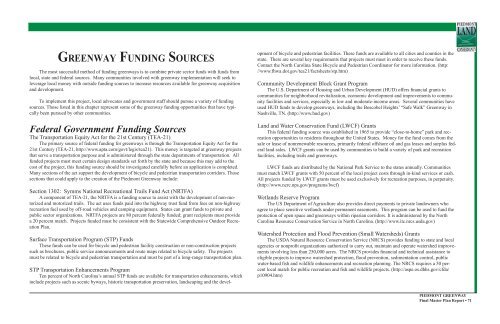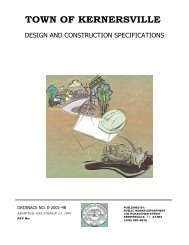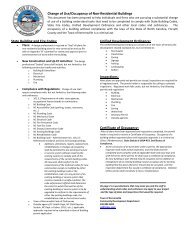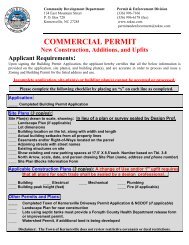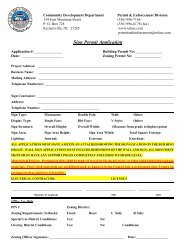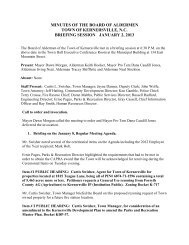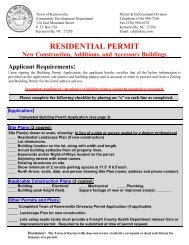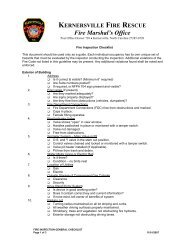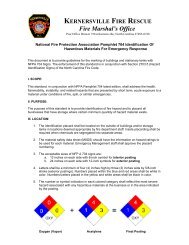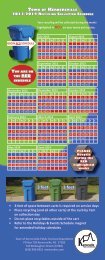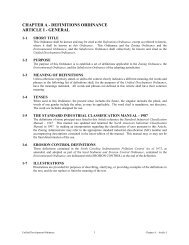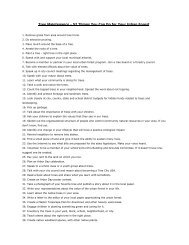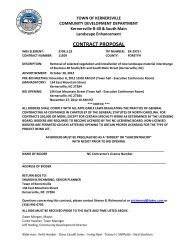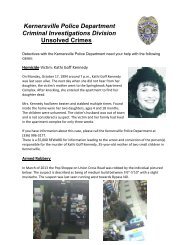Piedmont Greenway Master Plan - Town of Kernersville
Piedmont Greenway Master Plan - Town of Kernersville
Piedmont Greenway Master Plan - Town of Kernersville
- No tags were found...
Create successful ePaper yourself
Turn your PDF publications into a flip-book with our unique Google optimized e-Paper software.
GREENWAY FUNDING SOURCES<br />
The most successful method <strong>of</strong> funding greenways is to combine private sector funds with funds from<br />
local, state and federal sources. Many communities involved with greenway implementation will seek to<br />
leverage local money with outside funding sources to increase resources available for greenway acquisition<br />
and development.<br />
To implement this project, local advocates and government staff should pursue a variety <strong>of</strong> funding<br />
sources. Those listed in this chapter represent some <strong>of</strong> the greenway funding opportunities that have typically<br />
been pursued by other communities.<br />
Federal Government Funding Sources<br />
The Transportation Equity Act for the 21st Century (TEA-21)<br />
The primary source <strong>of</strong> federal funding for greenways is through the Transportation Equity Act for the<br />
21st Century (TEA-21, http://www.apta.com/govt/legis/tea21). This money is targeted at greenway projects<br />
that serve a transportation purpose and is administered through the state departments <strong>of</strong> transportation. All<br />
funded projects must meet certain design standards set forth by the state and because this may add to the<br />
cost <strong>of</strong> the project, this funding source should be investigated carefully before an application is completed.<br />
Many sections <strong>of</strong> the act support the development <strong>of</strong> bicycle and pedestrian transportation corridors. Those<br />
sections that could apply to the creation <strong>of</strong> the <strong>Piedmont</strong> <strong>Greenway</strong> include:<br />
Section 1302: Symms National Recreational Trails Fund Act (NRTFA)<br />
A component <strong>of</strong> TEA-21, the NRTFA is a funding source to assist with the development <strong>of</strong> non-motorized<br />
and motorized trails. The act uses funds paid into the highway trust fund from fees on non-highway<br />
recreation fuel used by <strong>of</strong>f-road vehicles and camping equipment. States can grant funds to private and<br />
public sector organizations. NRTFA projects are 80 percent federally funded; grant recipients must provide<br />
a 20 percent match. Projects funded must be consistent with the Statewide Comprehensive Outdoor Recreation<br />
<strong>Plan</strong>.<br />
Surface Transportation Program (STP) Funds<br />
These funds can be used for bicycle and pedestrian facility construction or non-construction projects<br />
such as brochures, public service announcements and route maps related to bicycle safety. The projects<br />
must be related to bicycle and pedestrian transportation and must be part <strong>of</strong> a long-range transportation plan.<br />
STP Transportation Enhancements Program<br />
Ten percent <strong>of</strong> North Carolina’s annual STP funds are available for transportation enhancements, which<br />
include projects such as scenic byways, historic transportation preservation, landscaping and the development<br />
<strong>of</strong> bicycle and pedestrian facilities. These funds are available to all cities and counties in the<br />
state. There are several key requirements that projects must meet in order to receive these funds.<br />
Contact the North Carolina State Bicycle and Pedestrian Coordinator for more information. (http:<br />
//www.fhwa.dot.gov/tea21/factsheets/stp.htm)<br />
Community Development Block Grant Program<br />
The U.S. Department <strong>of</strong> Housing and Urban Development (HUD) <strong>of</strong>fers financial grants to<br />
communities for neighborhood revitalization, economic development and improvements to community<br />
facilities and services, especially in low and moderate-income areas. Several communities have<br />
used HUD funds to develop greenways, including the Boscobel Heights’ “Safe Walk” <strong>Greenway</strong> in<br />
Nashville, TN. (http://www.hud.gov)<br />
Land and Water Conservation Fund (LWCF) Grants<br />
This federal funding source was established in 1965 to provide “close-to-home” park and recreation<br />
opportunities to residents throughout the United States. Money for the fund comes from the<br />
sale or lease <strong>of</strong> nonrenewable resources, primarily federal <strong>of</strong>fshore oil and gas leases and surplus federal<br />
land sales. LWCF grants can be used by communities to build a variety <strong>of</strong> park and recreation<br />
facilities, including trails and greenways.<br />
LWCF funds are distributed by the National Park Service to the states annually. Communities<br />
must match LWCF grants with 50 percent <strong>of</strong> the local project costs through in-kind services or cash.<br />
All projects funded by LWCF grants must be used exclusively for recreation purposes, in perpetuity.<br />
(http://www.ncrc.nps.gov/programs/lwcf)<br />
Wetlands Reserve Program<br />
The US Department <strong>of</strong> Agriculture also provides direct payments to private landowners who<br />
agree to place sensitive wetlands under permanent easements. This program can be used to fund the<br />
protection <strong>of</strong> open space and greenways within riparian corridors. It is administered by the North<br />
Carolina Resource Conservation Service in North Carolina. (http://www.itc.nrcs.usda.gov)<br />
Watershed Protection and Flood Prevention (Small Watersheds) Grants<br />
The USDA Natural Resource Conservation Service (NRCS) provides funding to state and local<br />
agencies or nonpr<strong>of</strong>it organizations authorized to carry out, maintain and operate watershed improvements<br />
involving less than 250,000 acres. The NRCS provides financial and technical assistance to<br />
eligible projects to improve watershed protection, flood prevention, sedimentation control, public<br />
water-based fish and wildlife enhancements and recreation planning. The NRCS requires a 50 percent<br />
local match for public recreation and fish and wildlife projects. (http://aspe.os.dhhs.gov/cfda/<br />
p10904.htm)<br />
PIEDMONT GREENWAY<br />
Final <strong>Master</strong> <strong>Plan</strong> Report • 71


